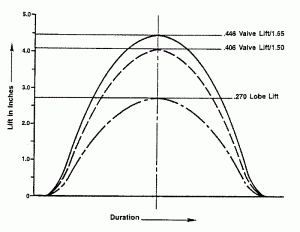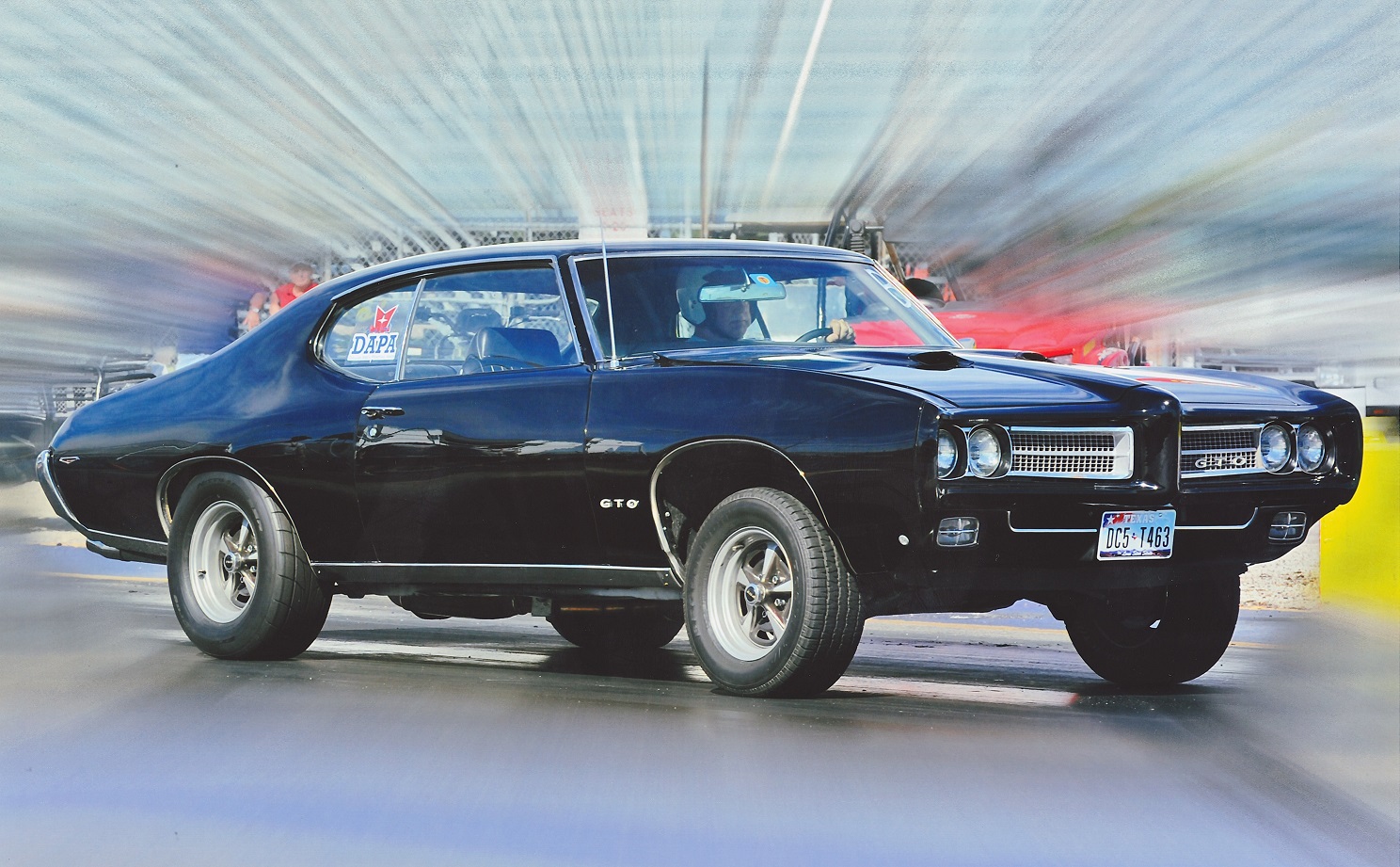Drag Racing with Jim Hand – Part 13: Reader Feedback – Rocker ratios
- March 16th, 2010
- Posted in Jim Hand: Drag Racing . Technical Articles
- By D.A.P.A
- Write comment
Our last column covered several subjects suggested by Fred Cailey from Batavia, Illinois. We have picked another from his excellent list and will discuss it in this part.
EFFECTS OF DIFFERENT RATIO ROCKER ARMS
Valve lift is determined by the combination of the cam lobe lift and the rocker arm ratio. A rocker arm ratio of 1.5 means that the actual cam lobe lift will be multiplied by 1.5. A typical Pontiac stock cam has a lobe lift of .270, and with a 1.5 ratio, the valve lift becomes a theoretical .406. However, the Pontiac rockers do not usually measure 1.5. I have measured several batches, and they are closer to 1.48. A set of Pontiac 1.65 rockers measure 1.62. By contrast, a set of Harland Sharp roller rockers measure 1.71. We can not verify that all Harland Sharp units measure 1.71, but they probably will always be more than 1.63. Are the higher ratios beneficial? Not necessarily. The following will review the effects of rocker arm changes (and will assume that the rockers measure the stated ratios).
We all know that a change from 1.5 to 1.65 rockers will increase the valve lift by 10%. This change on the typical stock cam will increase the lift from .406 to .446. As the stock heads will flow some increased amount of air in this lift range, and that airflow level can normally be used within the stock RPM, an increase in torque will usually be noted with this change on a stock lift cam. Additionally, the higher ratio rockers cause valve opening/closing slopes to change, thus adding valve open time within the same lobe design. These changes can usually be felt in normal driving, does not significantly increase wear on the valve-train, and does not adversely affect driveability (when used with stock cams other than the 041). Stock diameter 11/32 push-rods will usually clear the holes in the heads with higher lift rockers. A change to larger diameter push rods may require some modification to the push rod openings.
A second effect of larger rocker arms ratios is not as widely known. The effective valve open duration is extended 3 to 4 degrees, depending on the cam type, as measured at .050″ cam lift, when the ratio is changed from 1.5 to 1.65. As the valve lifts 10% greater but begins the lift at the same point, the opening and closing rates are steeper. This results in the valve reaching the .075 lift point (.050×1.5) earlier and effectively increasing duration. See illustration for this effect. Accordingly, we can change the effective cam duration by changing rocker arm ratios. With a Pontiac 068 cam, the timing changes from 212 degree intake and 225 degree exhaust to 215 I and 228 E., in addition to increasing the lift of both to .446, if the 1.5 arms are replaced by 1.65. Is this good? On any engine that can use the extended duration, it is very good. A 455 with the 068 will feel much stronger in the normal driving range and will pick up as much as .2 seconds in the 1/2 with this change. However, if the cam duration is already adequate with 1.5 ratio arms, the added duration caused by 1.65 arms may result in a loss of performance. We recently witnessed a 455 street car that runs in the 12.70 range with a 041 cam lose performance and driveability when the stock 1.5 rockers were replaced with a set of 1.65 Harland Sharp units. The 041 cam/1.5 rocker combination exactly matched the overall setup of this vehicle, and the increased cam timing unbalanced the combination.
A change in rocker arm ratio can provide a significant boost in usable power, or they can actually cause a loss, depending on what duration and lift the engine needs and what it has before the change. Note that push rod length and stiffness, and lifter leakage, can affect actual valve lift, but these factors will remain relatively constant. The real concern is not theoretical numbers, but how your engine responds to the overall combination.
Does higher ratio rockers cause increased wear/ breakage? In general, the side loading on the studs will increase. However, as the 1.65 rockers must be set at a different height to maintain proper valve-train geometry, it is necessary to replace the stock bottleneck studs with straight studs. Most after-market studs are more than adequate for strength. We strongly recommend that big block Chevy 7/16″ studs be used along with the polylock style lock nuts. A noted Pontiac Engineer advised that higher ratio rockers were chosen over a higher lift cam, because overall, less stress and strain on the complete valve train was required to obtain the same lift.
One last consideration in changing rocker ratios is the effect on valve springs. Springs are rated as to maximum permissible lift as well as the opening and closing pressures. Excessive lift may cause the spring coils to compress together during operation resulting in coil “bind”. As damage to valve train components can occur if coil bind is encountered, include this variable in your valve-train design. Very high lift cams and/or rocker combinations in conjunction with high compression can also cause valve to piston interference. It is relatively safe to change to total lifts below .520 in relation to valve/piston interference, but lifts above .520 and/or radical changes in valve timing will warrant serious review of the available clearances.
Do roller rockers add horsepower as claimed by the Vendors? As we noted in last month’s column, most of such claims can be documented in a laboratory. However, the slight reduction in friction and heat provided by full roller rockers on our large and relatively slow running Pontiac engines will be very difficult if not impossible to measure. If a different set of rockers improves performance, it is probably because the lift ratio better matched the specific engine. The real advantage in using full roller rockers is they minimize the valve stem side thrust and resulting wear in the valve guides. The stock style stamped rockers tend to push the valve stem side ways as they open and close the valve. This action wears the guides, which allows the valves to wobble and not set down squarely on the seat. This results in inaccurate valve timing as well as a loss in valve sealing. Full roller rockers installed with the correct geometry minimizes valve stem/ guide wear, and extends the useful life of both components. Be advised that roller rockers are usually noticeably noisier than stamped units. The mention of brand names is neither a recommendation nor a condemnation of specific products, but merely an example of what we have found in actual measurements of ratios.
Again, thanks to fellow Pontiac enthusiast Fred Cailey for his input.


